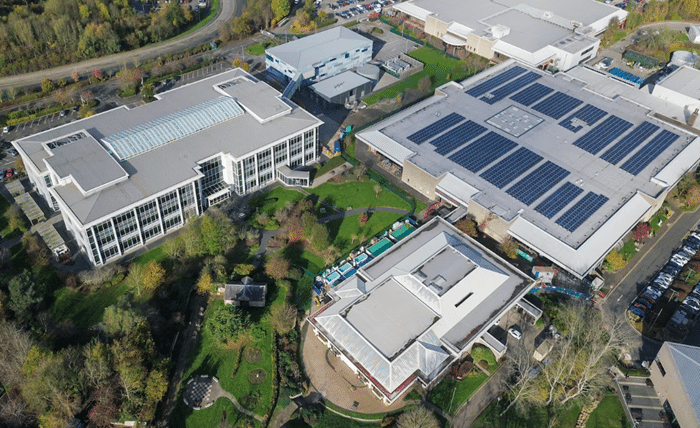
Solar energy is no longer confined to residential rooftops. As technology evolves, the applications of solar cells have expanded far beyond traditional installations. Today, solar cells are revolutionizing transportation, agriculture, consumer electronics, and even space exploration. These innovative uses showcase the incredible versatility and potential of solar technology in creating a sustainable future.
In this article, we’ll explore the diverse applications of beyond rooftop installations, highlighting how these powerful energy sources are being integrated into various industries and everyday life.
1. Solar-Powered Transportation
A. Solar Cars and Buses
One of the most exciting developments in green technology is the emergence of solar-powered vehicles. Solar cars, equipped with photovoltaic (PV) panels, convert sunlight directly into electricity to power the vehicle’s motor or charge its battery.
Cities around the world are testing powered buses, particularly for short urban routes. These buses reduce dependence on fossil fuels and lower carbon emissions, aligning with clean energy goals.
B. Solar Boats and Ferries
Marine transportation is also benefitting from solar technology. Solar boats and ferries use solar panels installed on the deck to charge onboard batteries, providing quiet and emission-free travel—especially ideal for tourism and eco-sensitive areas.
C. Solar Aircraft
Aircraft like the Solar Impulse have demonstrated the potential of solar-powered flight. These planes are equipped with thousands of lightweight solar cells and aim to achieve long-distance, emission-free aviation—a milestone for the future of clean air travel.
2. Solar in Consumer Electronics
A. Solar-Powered Chargers and Power Banks
Portable solar chargers and power banks are popular among travelers and campers. These compact devices harness sunlight to charge smartphones, tablets, cameras, and other gadgets without relying on the grid.
B. Solar Wearables
Smartwatches, fitness bands, and even smart clothing are integrating flexible solar cells to extend battery life. This development not only adds convenience but also promotes energy efficiency in wearable technology.
C. Solar Backpacks
Backpacks with built-in solar panels allow users to charge devices on the go, making them ideal for students, hikers, and professionals who need reliable portable power throughout the day.
3. Agricultural Applications of Solar Cells
A. Solar-Powered Irrigation Systems
Farmers are increasingly using solar energy to power water pumps for irrigation. These systems reduce the need for diesel generators and make water access more sustainable, particularly in off-grid and drought-prone regions.
B. Solar Greenhouses
Solar-integrated greenhouses utilize PV panels to generate electricity for lighting, ventilation, and temperature control. Some models also use transparent solar glass to allow light in while producing energy.
C. Agrivoltaics
Agrivoltaics refers to dual-use solar farming, where solar panels are installed above crops. This setup allows farmers to generate electricity while growing food, creating a win-win scenario. The panels also provide partial shade, reducing water evaporation and improving crop yield in some climates.
4. Solar Integration in Infrastructure
A. Solar Windows
Transparent or semi-transparent solar cells are being used to create solar windows. These can generate electricity while still allowing natural light into buildings. It’s an innovative solution for skyscrapers and urban areas with limited rooftop space.
B. Solar Roads and Pavements
Experimental solar roads embed durable PV panels into road surfaces to generate power while supporting traffic. While still in the early stages, this concept has been tested in countries like the Netherlands and France, showing potential for street lighting and smart city infrastructure.
C. Solar Noise Barriers
Highways are increasingly incorporating solar panels into sound barriers. These structures not only block noise but also generate electricity, turning passive infrastructure into active energy producers.
5. Off-Grid and Emergency Use
A. Remote Area Electrification
Solar mini-grids and standalone systems are bringing electricity to remote villages, islands, and off-grid communities. These systems are often cheaper and faster to deploy than traditional grid expansion.
B. Disaster Relief and Emergency Shelters
In the aftermath of natural disasters, electricity access becomes a critical need. Portable solar kits and solar tents provide emergency lighting, charging, and communication in areas where the grid is down or damaged.
C. Solar Water Purification Systems
Solar energy is used to power UV-based water purifiers or solar thermal distillers, providing clean drinking water in disaster zones or remote regions without infrastructure.
6. Solar in Military and Defense
The military is adopting solar-powered systems for field operations to reduce fuel dependency and increase operational efficiency. Solar tents, portable power stations, and unmanned aerial vehicles (UAVs) powered by solar panels are just a few examples.
Using solar energy reduces the need for supply convoys—often the target of attacks—and provides silent, low-maintenance energy solutions in hostile or remote areas. See examples of solceller på tag projects
7. Space and Satellite Applications
Since the 1950s, solar cells have powered satellites and spacecraft. These high-efficiency solar panels provide a continuous energy source in space, where sunlight is abundant and uninterrupted.
Modern space missions, such as Mars rovers and the International Space Station (ISS), rely heavily on solar energy for all their operations, making it a cornerstone of space exploration.
8. Building-Integrated Photovoltaics (BIPV)
Going beyond simple rooftop panels, BIPV systems are embedded directly into building materials such as:
- Roof shingles
- Façades
- Curtain walls
These installations combine aesthetics with functionality, enabling buildings to become net-zero or even energy-positive without compromising on design.
9. Solar Desalination and Water Systems
Freshwater scarcity is a growing concern. Solar-powered desalination plants are now being used to convert seawater into potable water using solar thermal or PV energy.
Solar water pumping and heating systems are also transforming water access and hygiene in underdeveloped areas, promoting better health and sustainability.
10. Art, Architecture, and Urban Design
Artists and architects are using aesthetic solar cells in creative ways:
- Solar sculptures that generate energy while serving as public art
- Solar-powered street furniture, including benches, lights, and charging stations
- Interactive installations that react to sunlight or generate visuals based on solar input
These applications combine sustainability with visual appeal, making solar integration more accepted and appreciated in urban environments.
Read more about Solee innovations
Conclusion
The use of solar cells is no longer limited to rooftops and grid-tied installations. From transportation and agriculture to military and consumer tech, solar energy is transforming every corner of our lives. These diverse applications not only reduce our dependence on fossil fuels but also bring sustainable power to remote, mobile, and emergency scenarios.
As technology advances and solar panels become more efficient and flexible, we can expect even more creative and practical applications of solar cells in the near future. Whether it’s charging your phone with a solar backpack or powering a Mars rover, the sun’s energy continues to illuminate possibilities beyond the conventional.




